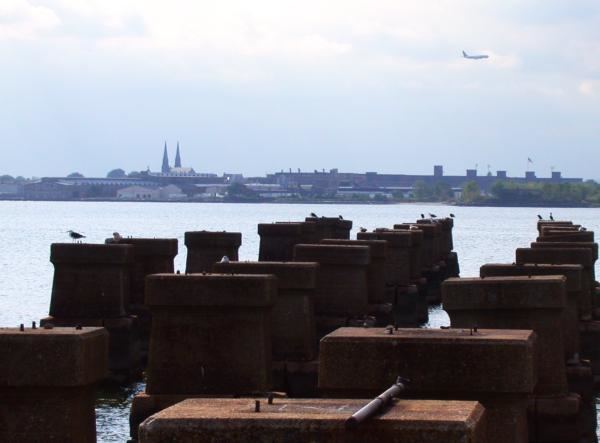Time 9:01 am EDT Type of incident Derailment into water Date 15 September 1958 Total number of deaths 48 Locations Newark Bay, Bayonne | Country United States Trains 1 Location Newark Bay, United States Injuries 48 | |
 | ||
Rail line Central Railroad of New Jersey main line Cause Signal passed at danger Operator Central Railroad of New Jersey Similar Norwalk rail accident, 1993 Big Bayou Canot trai, 1987 Maryland train colli | ||
The Newark Bay rail accident occurred on September 15, 1958 in Newark Bay, New Jersey. A Central Railroad of New Jersey (CRRNJ) morning commuter train, #3314, ran through a restrictive and a stop signal, derailed, and slid off the open Newark Bay lift bridge. Both diesel locomotives and the first two coaches plunged into Newark Bay and sank immediately, killing 48 people. A third coach, snagged by its rear truck (bogie), hung precariously off the lift bridge for two hours before it also toppled into the water. As the locomotive crew was killed, the cause of the accident was never determined, and was never reinvestigated.
Contents
Conditions
There were three signals spaced at three-quarters of a mile, a quarter of a mile, and 500 feet (150 m) from the draw bridge, and an automatic derailing device fifty feet beyond the third signal. The bridge span had to be down and locked electrically before the signals and derail devices could be cleared for movement on the track. Conversely, all the devices had to be in their most restrictive positions before the bridge could be unlocked and raised. The train ran through two signals and was derailed automatically; the automatic derailer was designed to knock the wheels off the track so that the resistance of the ties and ballast against the train's wheels would bring a slow-moving derailed train to a stop. Train #3314, although derailed, was moving at such a great speed that it did not have sufficient distance to stop before diving off the bridge.
Causes
The Interstate Commerce Commission, the New Jersey Public Utilities Commission, and the United States Army Corps of Engineers each conducted separate inquiries into the wreck, and all three found that the absence of a "dead man's control" was one primary cause of the accident. After the inquiries, the New Jersey Public Utilities Commission ordered the railroads to install such devices on all passenger locomotives operating in New Jersey. Some Jersey Central locomotives were equipped already with such devices, but this did not include the engine leading CNJ train #3314 on the day of the wreck. The railroad claimed that such a device was not always necessary, because all their trains had two crewmen in the locomotive cab. If the engineer was incapacitated somehow, the fireman would assume control of the locomotive.
An autopsy found that the engineer, 63-year-old Lloyd Wilburn, had indications of hypertensive heart disease, but that he had died of asphyxia due to drowning. However, no reason could be found to explain why fireman Peter Andrew, 42, could not or did not stop the train. Investigators raised the wreckage and did not find any defect of the braking system on the locomotives and coaches; it was also determined that the signal system and derailing device on the bridge had functioned properly. Lacking more definitive evidence, it was presumed that the engineer had somehow become incapacitated in the cab and the fireman failed to take appropriate action to stop the train. The presence of a deadman control in the locomotive cab might have averted the catastrophe, and, while the I.C.C. only "recommended" the installation of these devices, the New Jersey Board of Public Utilities directed that the railroad install them in all of its locomotives.
Aftermath
Forty-eight people died in the wreck, including former New York Yankees second baseman George "Snuffy" Stirnweiss and James Carmalt Adams, the brother-in-law of author Kurt Vonnegut. The railroad had a number of legal actions brought against it, which were all settled out of court. The two locomotives, #1532 and #1526, were raised, rebuilt by the Electro-Motive Division of General Motors (EMD) and returned to service. Locomotive #1532 retained its original number, while the #1526 was renumbered #1531. They served primarily as freight locomotives, although the #1532 was photographed in passenger service after its return from EMD. The Newark Bay lift bridge was last used during 1978 and was determined to be a hazard to navigation; it was demolished during the 1980s.
